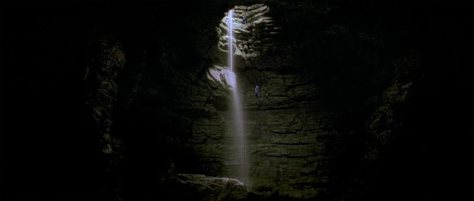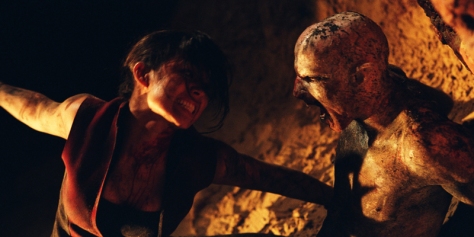
If there is any consistent thread you can find throughout the most well-regarded monster movies that premiered after the new millennium, it’s an attempt to bring a classical sense of economy and imagination to a subgenre that had been overtaken by bloat and complacency. While the possibilities of digital filmmaking are utilized, special effects are kept practical, both in the sense of being generally handmade and in that they are cost-efficient and serve a purpose other than showcasing soon-to-be-outdated CGI rigs—that also means budgets are low enough that actual risks can be taken in the subject matter and tone. Neil Marshall’s The Descent is generally held up as one of the best examples of that: here is a horror film based not on impossible effects or haunted house thrills, but a general ratcheting of dread to the point of physical discomfort, one that builds from a grounded place and then introduces its monsters as a form of escalation. This is a return to some of the most unsparing horror of the seventies and eighties, while adding some of its own stylistic touches that mark it as part of a growing movement of bold experiments from genre experts.


In a direct contrast to Marshall’s 2002 cult werewolf film Dog Soldiers and its all-male ensemble, The Descent’s core group are all women, even more of a rarity then then it is now. Their portrayal is naturalistic, particular relationships between most of them established from casual conversations that occur before the titular descent even begins—we understand enough about them when they laugh and joke early on, and then see those personalities play out when placed in a seemingly no-win situation later, and they remain generally believable throughout, never devolving into mere archetypes. There are some slight exceptions to this cinéma vérité dynamic, though: a much more openly dramatic story brews between Sarah (Shauna McDonald), our designated lead, and her estranged friend Juno (Natalie Mendoza), who is the one taking charge of trip and who Sarah feels some barely contained animosity towards. This is set up in the opening sequence, where we establish these friends as fearless thrill-seekers, and then watch as Sarah’s husband and daughter die in a traffic accident so horrific that it would likely be comical if the film didn’t take Sarah’s subsequent emotional trauma as seriously as it does. A few jump scare dream sequences are integrated into the early goings, keeping our sense of reality in question and preparing us for the horrors that eventually come our way.

The fuzzy borders of the real world and Sarah’s sorrow-induced lapses embody the movie’s trademark vacillation between almost documentary-like realism and hyper-stylization, a tonal balance it manages to keep even as it gradually becomes more of a horror movie. This begins with the environments: there is something both beautiful and ominous in the blue and green shades of the wilderness as our crew drives off-road to their destination, a feel that is carried into the cave they begin to explore, a place of little visibility and increasing narrowness, which they delve into further and further even as individual members begin to question the risks of doing so. The realism plays a big part in making the first third of the movie, where their caving expedition become increasingly dire, into perhaps one of the most intense, stomach-knotting experiences in a movie: these places do not feel like a set, but a truly isolated environment that threatens to trap these people at any moment, every new tunnel and chasm they need to cling over presenting an imminent disaster that is convincingly visceral. With the only real sources of light being flashlights, flares, and the night vision lens of a digital video camera—an intrusion of mixed media imagery that feels like a forward-looking nod to the still incubating found footage genre that The Blair Witch Project seeded six years earlier, and is regularly used here as a source of unique terror imagery—we are never even really sure what’s actually there most of the time. It’s incredible to think that all the cave scenes were filmed entirely at England’s Pinewood Studios, with the darkness and clever filming making the limited number of rock configurations seem endless—the sheer inescapable claustrophobia makes even the pre-monster sequences harrowing.

Things continually worsen as they venture deeper into the cave looking to find a second opening that may not actually exist, their constant reassurances to each other sounding genuine but increasingly unsure, and then when the monsters finally begin to make their appearance, the situation becomes nightmarish in an entirely new way. You could argue that the sudden inclusion of pale predators stalking our cast is not nearly as affecting as simply watching one of them struggle to make their way over a open pit—but the portrayal of the monsters does maintain the same sense of unrelenting panic, presented a new obstacle whose presence is threatening to our cast both physically and to their ever-fraying emotional states. The monsters, called “crawlers” by the film’s crew, have all the disturbing mottled and textured qualities of the decade’s most popular heavy make-up effects (suddenly everything started looking like a Lord of the Rings orc) but are also streamlined in a way that seems decidedly old school, like a slightly more advanced version of a seventies horror movie simply making due—the decision to keep the designs recognizably human even with their Nosferatu-like heads (the implication being that they are offshoots of humanity that adapted to living in the caves thousands of years ago), makes their threat feel less abstract. There were so many horror movies about waves of mauling humanoid creatures at that time, zombie or otherwise, but through the use of the movie’s environment-devouring shadows and the simple but effective animalistic acting of the people behind the monster make-up, their relentless brutality never feels as weightless as many of the horde horrors that followed this.

By their nature, the crawlers can seemingly appear anywhere, flitting in and out of view by scaling the walls, their gleaming albino forms popping from the darkness with a speed that is terrifying but not ridiculous. The first time you see one of them on-screen, as a crouching figure in the distance that skitters away when it feels the presence of intruders, it is one of those effective introductory shots that horror movies (especially the previously mentioned found footage ones) strive to replicate with rare success. The subsequent winnowing down of the cast—all the more painful after the non-monster ordeals they already had to go through—wisely lack the rhyme and reason that would make it feel like traditionally controlled movie stake-raising, rather than the chaos this movie calls for.

This is also where it begins to take more liberties with reality: the scenes pick up in manic pace, sets are bathed in harsh reds (contrasting the ghoulish hues of the moments seen through the video camera), and some of our characters actively and bloodily fight back against their attackers. In the composition and gravity of these moments, they become pure action movie style, the kind that I’m sure Marshall continued to develop in later movies like his post-apocalyptic thriller Doomsday (his direct follow-up The Descent.) Given the hewing to more real life emotions and reactions from the characters previously, these brief hops into pure genre imagery might feel discordant, and yet they still work regardless—I think it’s because they fit so well into the viciousness of the violence we’d seen so far, the moment when Sarah and Juno specifically begin perforating the crawlers with hooks and pickaxes being built out of a growing desperation that eventually boils over. It also never shies away from making that violence feel far from triumphant—after brutalizing one monster, Juno becomes so defensively twitchy that she accidentally plants a hook in the neck of one of her friends. Horror is not sacrificed in order to create some cinematic flair, which requires some deft genre navigation skills.

The looks in the actresses eyes as they engage in gory finishing moves tells you that they’re not simply trying to survive at that point, but that they have been forced to leave their humanity behind. We can guess that Sarah and Juno, who spend some of this section of the movie separated, will likely be there for the finale just based on the attention lavished on their history together—the primary character tension has been the implication, later confirmed, that Juno had an affair with Sarah’s late husband which may have contributed to the accident that killed him—and that development plays heavily into the finale, which follows Sarah’s gradual disintegration into animal fury following a scene where she emerges from a literal pool of blood. The interpersonal tension between the two, and how the audience is meant to interpret it, is not terribly ambiguous, with Juno saddled with the blame for putting them in the situation in the first place (by guiding them to an unexplored cave rather than the established one they were planning on), a few moments where she puts panicked self-preservation over helping her friends (as we saw after her accident with the hook), and, connected to both, the suggestion that she is so detached from other people that she thought returning to the recklessness of their youths would repair the broken relationship between her and Sarah. With all that moral weight placed on her shoulders, Sarah’s subsequent actions seem to have some justification, at least in terms of movie moral logic—but after watching the two of them mutilate the monsters by, say, pushing their vestigial eyeballs back into their skulls, any sort of moral clarity seems murky at best. The events of the movie have driven both of them over the edge, and they become the most explosive expressions of their own inner turmoil—they have not, as the cliche would go, become indistinguishable from the monsters, but they have certainly become acclimated to the monsters’ unforgiving environment. Famously, the movie’s original ending was cut off in the North American version, concluding at the point where Sarah seemingly escapes the cave only to be confronted by a mutilated vision of Juno in her vehicle’s passenger seat, but without the part that reveals that to be another dream sequence, as she remains trapped underground—test audiences thought the full ending was too bleak. As Marshall himself points out in interviews, though, the edited ending is not actually less bleak—in both cases, Sarah seems to be trapped forever in the horrors she has experienced.

I guess the tonal difference in the ending is really only in the degree of it, but not in the underlying sentiment—and the unrelenting bleakness is one of the things that marks The Descent as a seminal piece of its era. Rarely do you see a creature feature push things to those extremes, but here was one given the freedom to do so—and with its sense of genre awareness, it is willing to not just indulge in consciously memorable imagery, but to have the confidence to make its emotional core feel uniquely raw. The careful finagling of effective monster movie thrills with a desire to include actual tempestuous humanity at their centre becomes a core feature of subsequent monster movie milestones—this would be followed a year later by previous Creature Classic The Host, and years later you can even sense a similar approach in movies like It Follows, which sympathizes with characters in a personal, doom-laden scenario. The innovation here is not abandoning genre trappings and style, but imbuing it with a closely-observed reality that makes the genre bits hit even harder.
